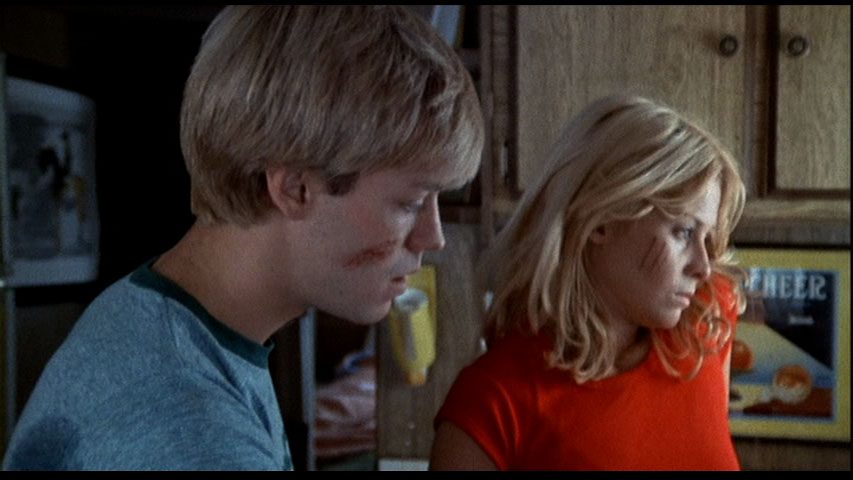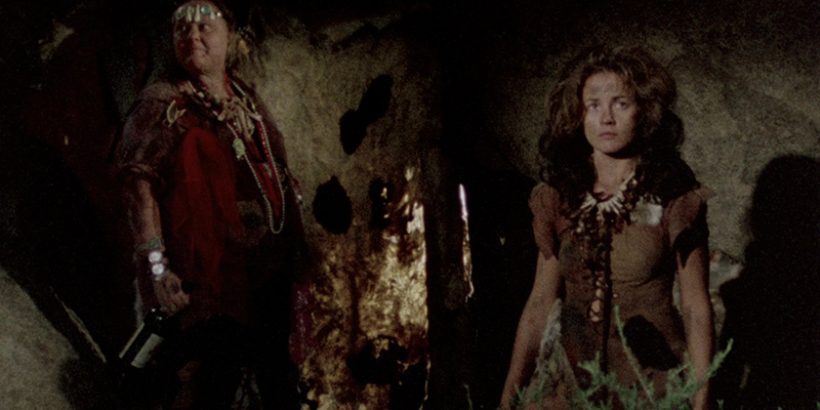“Stay on the main road, ya hear? Stay on the main road!”
What I’ve always loved about Wes Craven is how quickly he gets his films going – he’s all killer, no filler. Look at the jaw-dropping openings of Scream or A Nightmare on Elm Street. In The Hills Have Eyes, he starts in the middle of an escape. An old man named Fred is packing up his truck and leaving town – what little town there is to leave. The town looks deserted, is certainly desolate, and a sign on Fred’s gas station announces it as the last stop for 200 miles. A girl named Ruby approaches him, asks to come with. It’s revealed that this town’s economy runs on the barter system. Fred turns Ruby down and chastises her for helping to rob an Air Force PX. Mention is made of someone called Jupiter. A hill is ominously referred to.
Hills, as the title implies, surround the tiny town in the middle of the desert leading to California. They transmit an air of impenetrability and unknowability. One feels trapped. Certainly that is the fate of the Carter family – Bob and Ethel, their children Brenda, Lynne, and Bobby, and Lynne’s husband Doug, along with the newborn Katy – who stop at Fred’s for gas. He warns them against going into the hills to look for souvenir silver. But the family leaves anyway, and soon Fred’s truck is blown up, a punishment for his desertion.
The Hills Have Eyes got a remake in 2006 (which we’ll look at tomorrow), so the premise is pretty well-known: the car breaks down and the Carter family find themselves under attack by a cannibalistic clan of mutated savages. It’s well-worn territory – a version of this makes up the second half of Bone Tomahawk, one of the best horror movies in recent memory – but it started here. With such a sensational premise, it’s admirable how much Craven holds back. Unfortunately, at times he holds back too much.
When this technique works, though, it works well. Lynne sees a huge tarantula in the family’s trailer, as if the desert is slowly invading their lives. When she radios for help on the CB, she hears nothing on the other end but animalistic grunts. One of the dogs, Beauty, runs away. Bobby chases her and soon hears a struggle. He finds Beauty, dead and mangled. Craven was one of the best in his class at staging gore – some scenes in The Last House on the Left make me squirm just thinking about them – but he backs away from the temptation to go big, with one notable exception: the death of Bob Carter, one of the more impressively nihilistic killings Craven ever put on film.
Bob goes back to Fred’s for help, and Fred tells him a story of his wife dying giving birth to an enormous twenty-pound baby. The baby grew up into a sadistic teen, and Fred left the kid in the desert. The kid grew up to be Jupiter. (Craven withholds his big bad for a while, allowing the film to build the legend.) Fred is killed, in a sequence that includes a crowbar beating which would be more effective if it were bloodier. (The Hills Have Eyes originally got an X rating; I have no idea why.) Jupiter has more in store for Bob, though: he crucifies him to a tree and sets him on fire.
Let’s get this out of the way: the cannibals themselves are not that scary. One could blame the performances. As Jupiter, James Whitworth isn’t bad, strictly speaking, but he’s not the mythic figure the film needs him to be, and the wide scar across his nose and cheek only looks like a hastily applied prosthetic. Mars (Lance Gordon) speaks with an incomprehensible Southern accent that makes no sense – they live near the California border, where no one talks like that. Did he train himself to do it? Is it an affectation? Did everyone talk like that in his formative years, causing him to grow up with the accent? I have so many questions. Michael Berryman makes more of an impression as Pluto, but that might be because the film’s entire promotional campaign apparently centered around him.
The actors playing the Carters are all more or less capable. It’s fun to see Dee Wallace as Lynne, knowing that a few years after this she’d give one of her best performances, in Cujo. Doug looks goofy even by 1970s standards. The best performance by a mile is that of Robert Houston, who plays Bobby. Through context, we surmise that Bobby is 18 or 19, and Houston hits that note perfectly. He’s a bit of a smartass, but he allows himself to be vulnerable and scared. There’s a core of decency in Bobby; when things start to go awry, he keeps his worries to himself, not wanting to terrify his family. I can’t say with any certitude if Craven took more time with Bobby than with the rest of the characters, but I can easily say that, thanks to Houston’s performance, Bobby is the one who feels the most human.
Ultimately, the violence in The Hills Have Eyes is pretty bland, which is doubly disappointing coming from Craven. I expected to have a tough time watching this, but the reputation this film has is frankly unearned. Bob’s death is grandiose and macabre, but most characters are dispatched through simple stabbings or shootings. What’s surprising, though, is the film’s strangely progressive gender dynamics. There’s very little macho posturing from the men (with the occasional exception of Bob) – Doug and Bobby are ready to admit they don’t know what’s happening or how to react to it. When Jupiter and Mars are killed, it’s largely because of the women; Brenda gets Jupiter in the back with a hatchet, and Ruby gets Mars bit by a rattlesnake.
Some horror movies age better than others. Not to sound redundant, but The Last House on the Left is still hard to watch, 45 years later. But The Hills Have Eyes just looks dated now. Craven would become one of the all-time greats, but this film isn’t one of his more impressive achievements. And it’s definitely not the classic that it’s made out to be.
10/1: Dawn of the Dead
10/2: Drag Me to Hell
10/3: Pet Sematary
10/4: The Descent
10/5: Repo! The Genetic Opera
10/6: Desierto
10/7: The Blair Witch Project
10/8: Blair Witch
10/9: The Texas Chainsaw Massacre
10/10: A Nightmare on Elm Street (2010)
10/11: Prince of Darkness
10/12: 30 Days of Night
10/13: Friday the 13th (2009)
10/14: Slither
10/15: Tremors
10/16: Pandorum
10/17: It Follows
10/18: A Girl Walks Home Alone at Night
10/19: Poltergeist
10/20: Paranormal Activity
10/21: Creepshow
10/22: VHS
10/23: Nosferatu the Vampyre
10/24: An American Werewolf in London
10/25: The Witch
10/26: The Rocky Horror Picture Show
10/27: Cronos
10/28: The Hills Have Eyes
10/29: The Hills Have Eyes (2006)
10/30: Tucker and Dale vs. Evil
10/31: Halloween (2007)



